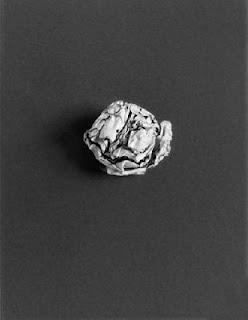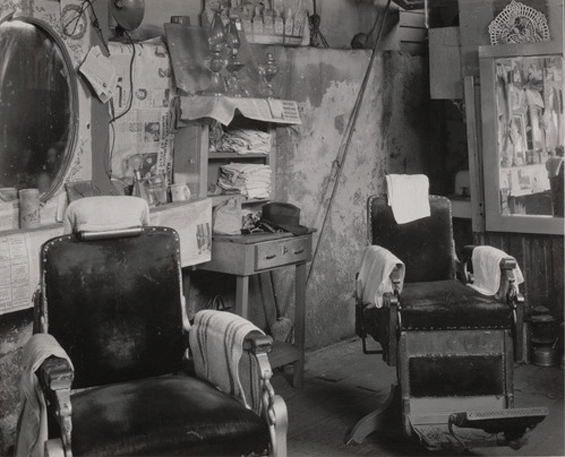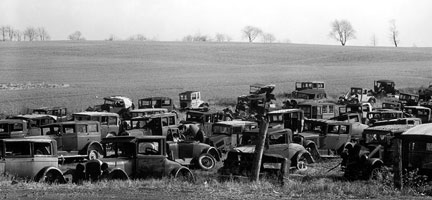From the earliest days of photography photographers were divided about whether it was an extension of art (see Photography set up and make believe) or a new thing altogether. A new device that captures the world through a cold harsh objective lens - in effect - A new way of seeing and creating images. The debate still rages today - "Is Photography Art?' and many leading critics agree ultimately it is. Does photography really need this close link to art, or is it, ultimately, its own thing. Geoff Dyer argues that photography nature is enough and that it shouldn't hold artistic pretensions (read here).
These feeling were shared by Eugene Atget who had no artistic claims for his pictures. He saw his (now iconic) images of Paris as 'Documents for Artists' and sold them to government archives or private clients who wanted them for visual references. Photography has been used for genuine science, pseudo science, journalism (documentary photography) and documentation.
These images by Eugene Atget show Paris caught at night and in the early hours of the morning. These city shots have no people in them - a world built by people for people but empty. The same space that during the day would be full of people take on a new life at night - they become deserted and eerie. The images have a still, quite quality about them and their subtle sepia tone give the sense of looking at a forgotten world.
Atget spent his career documenting Paris often combining the old with the modern. This image, from his later period, shows the height of French fashion with the reflection of the three hundred year old Gobelins complex. People rarely appear in his images - only the traces of people remain. He would document Paris's grandest building and most humble corners. Advertising and shop windows were unusual themes for Photography - his images were mainly taken as reference for other artists and illustrators. He was relatively unknown in his time but Man Ray, who lived only a few doors away from Atget, had been the first to celebrate his work. Man Ray saw Atget's work as a kind of naive proto-surrealism. Atget's unique eye and straightforward approach can be seen in the objective look of future generations like Walker Evans, Stephen Shore and Lee Friedlander.

Examples of the work of Karl Blossfeldt (1865 to 1932)
Sculptor & art teacher Karl Blossfeldt is best known for his beautiful photographs of plants forms. The close up images help us see, through the cameras lens, images we wouldn't see with our eyes. Seed, leaves and stems appear as figures or alien creatures. Strange sculptural objects and forms are found in nature. A systematic objective approach that seems to show us the real world actually abstracts it and makes it strange.
Originally, the photographs were intended to be used as teaching aids - subjects for art students to work from,. However, the images became popular when a selection of his photographs were published in the book Urformen der Kunst (Archetypes of Art) in 1928. The book created a sensation in the photographic world & Blossfeldt was rushed to the fore in the German post World War I movement to abandon the soft focus, impressionistic style in favor of a direct lighting & sharp focus approach. His direct objective approach towards photography and his methodical use of a system predicted the way many modern photographers work.

Suren Manvelyan 'Your Beautiful Eye'
These images by Suran Manvelyan uses a macro lens to show the human eye in detail. They look like planets, craters, rivers and mountain ranges. Like Blossfeldt the hyper real approach actually has the opposite effect - the seem alien to us. These images have been described as beautiful, which on one level they are, but they are also ugly and terrifying.
Stephen Gill 'A series of Dissapointments'
Stephen Gill is a contemporary British photographer who often works in a series. He will often focus on subject you would normally pay no attention to - A lost stranger looking at a map, painted over signs, the backs of bill boards or people sat on trains. His work shares the straight forward irony of martin Parr, the cold methodical approach of The Bechers and the fascination with the everyday of Walker Evans.
His series 'A Series of Dissappointments' looks at the proliferation of betting shops in the Borough of Hackney. The discarded slips 'were shaped by loss or defeat, then cast aside. these new forms perhaps now possess a state of mind, shaped by nervous tension and grief. After these images were made, little autopsies were performed on the papers to reveal the failed bets held within.'
Bernd & Hilla Becher, Gas Tanks, 1983-92 The series of images above are by Bernd and Hilla Becher. They are a husband and wife team who are famous for taking photographs of obsolete industrial architecture. The beauty of the buildings comes from their form following their function. These images are photographed in a systematic way, from the same viewpoint and displayed in a uniform grid formation. From this pseudo-scientific approach a simplistic beauty emerges. Idris Khan, 'every…Bernd and Hilla Becher Spherical type Gasholders' 2004 Idris Khan is a contemporary photographer who overlays the work of others on top of one another. The top image shows where Khan overlaid the Bechers water tower series. This has given the image the feel of a charcoal drawing and the images have an eerie, ghostlike atmosphere. Although these images are not fast shutter speed examples they show a life times work in an instant – warping time by showing the work in an instant. Bernd and Hilla Becher The Becher's were part of the "New Topographics: Photographs of a Man Altered Landscape" exhibition in New York (1975). The work in this exhibition was presented uni formally (Each photographer in the New Topographics exhibition was represented by 10 prints. All but Stephen Shore worked in black and white). Each photographer looked at the modern landscape and their work had a cold objective feel. This influential exhibition included The Bechers, Henry Wessel, Stephen Shore, Robert Adams and Nicholas Nixon. Nicholas Nixon 'The Brown Sisters 1975-2007' 2/16/09 Nicholas Nixon 'The Brown Sisters 1975-2007' Time has a natural effect on the world around us. Time is a central element of Photography - at it purest form it can be the length of time a shutter is left open for. On another level it can record time - freezing it forever. We cannot see time - we invented clocks to give form to this abstract concept. However, we can see the effects of time - the sun moving over head, a worn step, a landscape eroding or the aging effect on humans. We notice people growing old mainly by looking back at old photographs. The Photographer Nicholas Nixon has Photographed his wife and her three sisters ever year since 1975. They are informal portraits but the women are always stood in the same order. If you look at the photographs chronologically the change is subtle. However, if you look at a photograph from the 1970's and compare it to a recent one the change is dramatic. Soft skin and features age and show the marks of a life's experience. Individuals faces can still be recognised but, at the same time, can change dramatically. This work could also be described as a Sequence because the images should go in a certain order. “Following Walker Evans’s example, a postwar generation focused on what everybody in America during the 1950s, 60s and 70s actually saw in front of their faces or through their windshields or across their backyard fences, but didn’t bother to register or preferred not to – much less to think was worth photographing. These were run of the mill subjects, mostly, shot with deadpan acumen.. seemingly nowhere places, shown to be somewhere after all. In the populist spirit of Walt Whitman, but with a heavy dose of dry-eyed skepticism, they found a fresh kind of poetics in the American everyday… [Wessel] had a knack for seeing a compositional order where it didn’t obviously present itself – making pictures like visual haikus.” - Michael Kimmelman Walker Evans 'Subway Portraits' In the 1930s Walker Evans photographed passengers in the New Yorker Subway. Using a 35mm camera hidden under his coat he captured the person opposite unobserved. This selection of portraits of women, intended for an earlier unpublished version of 'Many Are Called' which Evans called 'The Passengers (Hidden Camera in the New York Subway)', was compiled around 1961. Sarah Greenough said of The Passengers: "[It] emphasizes the mug-shot-like quality of some of the photographs". The complex work of Walker Evans combines confronting the surveillance and depicting process used by the police with other aspects – such as generating the anonymous in the realm of modern urban life". |
A section from Peter Blakes Alphabet (after Walker Evan) 2003
The British Pop artist Peter Blake created a whole alphabet by taking close up shots of street signs. Blake was inspired by the American photographer Walker Evans who, after a life of black and white photography, used a cheap colour Polaroid camera to photograph the every day and mundane. Blake, like many artists, has several collections. Like a magpie he collects anything that captures his eye. Blake's collection was shown at the Museum of Everything #3 in an old warehouse.
Walker Evans 'Barber Shop Interior, Atlanta' 1936
Walker Evans is one of the key photographers of the twentieth century. His keen, objective images have had a substantial effect on the medium. He captured crisp images of subjects that most photographers wouldn't look at - An old sign, an open door, a shop window. He originally wanted to be a writer and his images seem like descriptions from literature e.g.. an Interior of an old barber shop.
Evans would photograph things that at the time seemed everyday but he knew in the future would be of interest. This image of a petrol pump station seems intriguing today with its combination of hand painted signs and old fashioned looking petrol pumps. If the the pumps were around today they would be antique and photography has that ability to freeze time. Every photography is tinged with nostalgia.
Walker Evans, "Joe’s Auto Graveyard, Pennsylvania," 1936
Walker Evans Polaroid from 1970's
Evans was aware an old object discarded would have worth when viewed in the future. Cars are designed to be used and, like chairs, when they are abandoned they seem sad. They almost have human qualities - we can almost make out faces in their features.
Signs Collected by Walker Evans 1970-75
Evans also collected objects - trash, signs, bottle tops. He collected objects in the same way as he collected photographs - as if the camera has the ability to capture a piece of the world with a click of a button.
'Signs, New York' 1928–30 Walker Evans
Is there a huge difference between taking a photograph of a sign and collecting one off the street. In both cases you end up 'owning' it.
Evans was also aware of how a photograph or a sign preserves a passed society - and the more time passes the more exotic the photograph or object can become. A photograph is a moment in time but it can also contain years, decades.
Walker Evans - Penny Picture Display, Savannah, Georgia 1936
In this photograph by Evans he has photographed a set of Photographs. This is something he returned to again and again - the layers build up and you are looking at an image of an image. It is a shop window display in a penny photo arcade - people would go in to have a portrait taken as a memory. We photograph ourselves to prove we existed - we were here. These original images are not art in themselves but Evans photographs them and draws our attention to them. The act of using the work of others is know as Appropriating.
In 1877 Eadweard Muybridge helped the governor of California to win a $25,000
bet that at some point when a horse was running; all four hooves would leave the ground.
He set up a row of multiple cameras and each time the horse tripped a wire a photograph was taken. He ended up with a series of images that when combined created some of the first moving images. Without the likes of Muybridge there would no cinema, TV or most of the content on the Internet.
bet that at some point when a horse was running; all four hooves would leave the ground.
He set up a row of multiple cameras and each time the horse tripped a wire a photograph was taken. He ended up with a series of images that when combined created some of the first moving images. Without the likes of Muybridge there would no cinema, TV or most of the content on the Internet.
This is a sequence of shots by Muybridge's taken from two different angles. In his later career he would develop this idea further. In his early work the camera would be it a line and be triggered one after the other - documenting movement. In his later experiments the cameras would be in a circle and take a picture at the same time.
A similar technique was used in the film ‘The Matrix’ to create the Bullet Time effect.
The zoopraxiscope is an early device for displaying motion pictures. Created by photographic pioneer Eadweard Muybridge in 1879, it may be considered the first movie projector. The zoopraxiscope projected images from rotating glass disks in rapid succession to give the impression of motion. The stop-motion images were initially painted onto the glass, as silhouettes.
The device appears to have been one of the primary inspirations for Thomas Edison and William Kennedy Dickson's Kinetoscope, the first commercial film exhibition system.
Etienne-Jules Marey created similar images. Marey was a scientist who used art whereas Muybridge was an artist who created pseudo-scientific images. However, Marey's images were slow shutter speed shots and he used a strobe light. As the strobe flashed it created an image of the figure - therefore creating multiple figures showing the subject move though time and space.
These images above are by the photographer Harold Edgerton.
Photography is, in many ways, where art and science meet and these images show Edgerton’s experiments with high speed photography. The top image shows a drop of milk landing onto of a red biscuit tin lid – creating a beautiful crown. The bold white contrasts against the rich red and the rim of the lid adds an unusual horizon line to the composition. This is one of Edgerton’s most famous images and is actually the result of years of experimenting. He produced many of these images and many were not successful. This image is the result of experimentation and dedication. A flash would have been used to capture this moment in time.
The image on the bottom was created by having the camera on a tripod and using a slow shutter speed. However, Edgerton used a strobe light – each time it flashed it captured the figure in mid movement.











































